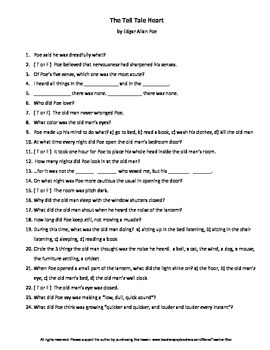

His senses became even more acute and he could hear the old man’s heart beating which made him even angrier. The narrator didn’t see anything but the eye. He opened it slowly and as the light entered the room it fell onto the old man’s eye. He stood silently waiting for the old man to go to sleep but the old man didn’t move also just waiting and listening.įinally, the narrator decided to open up the crevice in his lantern. He stood incredibly still knowing that the old man couldn’t see him because the room was so dark. The old man asked who was there but the narrator didn’t reply. However, on the eighth night, the old man woke up as the narrator entered his room. His secret visits continued for seven nights. The narrator assures us that it wasn’t the old man that angered him but that it was just the eye that he wanted to destroy.Īnd this I did for seven long nights-every night just at midnight-but I found the eye always closed and so it was impossible to do the work for it was not the old man who vexed me, but his Evil Eye. He would shine his lantern into the room but would never see the “Evil Eye” because the old man was fast asleep. The Tell Tale Heart | Edgar Allan PoeĮvery night at about midnight the narrator would secretly visit the old man’s bedroom. Whenever it fell upon me, my blood ran cold and so by degrees-very gradually-I made up my mind to take the life of the old man, and thus rid myself of the eye forever. I think it was his eye! yes, it was this! He had the eye of a vulture-a pale blue eye, with a film over it. "The Tell-Tale Heart" is widely considered a classic of the Gothic fiction genre and one of Poe's most famous short stories.I loved the old man. The story was first published in James Russell Lowell's The Pioneer in January 1843. The ambiguity and lack of details about the two main characters stand in stark contrast to the specific plot details leading up to the murder.

It has been suggested that the old man is a father figure or, perhaps, that his vulture eye represents some sort of veiled secret. It is unclear what relationship, if any, the old man and his murderer share. Ultimately the narrator's guilt manifests itself in the hallucination that the man's heart is still beating under the floorboards. The murder is carefully calculated, and the murderer hides the body by cutting it into pieces and hiding it under the floorboards.

It follows an unnamed narrator who insists on his sanity after murdering an old man with a "vulture eye". "The Tell-Tale Heart" is a short story by Edgar Allan Poe first published in 1843.


 0 kommentar(er)
0 kommentar(er)
